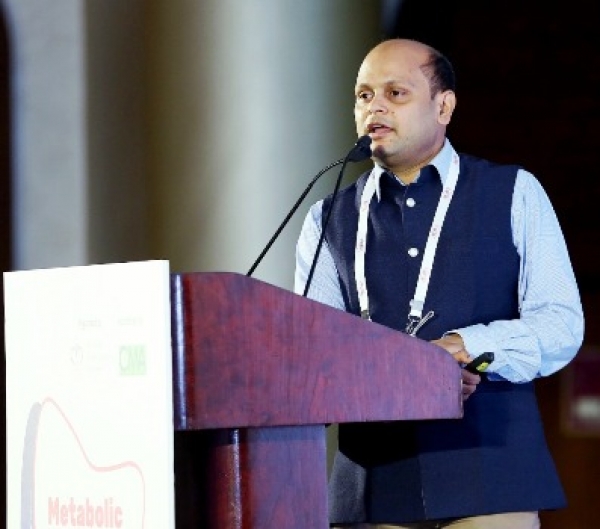
Odishabarta
Dr Sunil Kumar Kota,
Consultant Endocrinologist,Diabetes & Endocare Clinic
Berhampur:13/11/19:Diabetes confers an increased risk of developing and dying from infectious diseases. The morbidity and mortality associated with preventable infectious diseases like influenza and pneumonia, are also very high. Although people of all ages are prone to infectious diseases like pneumonia and influenza, extremes of age and certain underlying medical conditions such as diabetes, asthma, and cardiovascular disease (CVD) aggravate the risk.The increased susceptibility of diabetes subjects to pneumonia is mainly due to hyperglycemia, poor long-term diabetes control, longer duration of diabetes, decreased immunity, impaired lung function, pulmonary micro angiopathy, increased risk of aspiration and coexisting morbidity. Longer duration of diabetes and poor glycemic control causes a 25-75% increase in the relative risk of pneumonia-related hospitalizations in diabetes subjects.
Common infections in Diabetes:People with diabetes are three times at higher risk of death due to pneumonia-related complications. Patients with Type 1 diabetes and type 2 diabetes have a 4.4- and 1.2-fold risk of pneumonia-related hospitalizations. Diabetes subjects with a HbA1c ≥9% are at 60% increased risk of pneumonia-related hospitalization.
People with diabetes are six times more likely to be hospitalized during an influenza epidemic with the mortality varying between 5% and 15%. Risk for CVD is already 2-4 fold higher in this sub group. Patients with diabetes are at a 2.1 times increased risk of infection by the HBV (Hepatitis B virus) than nondiabetics. HBV can be transmitted by medical equipment that is contaminated with blood that is not visible to the unaided eye like finger stick devices.
Recommendations for various vaccinations:
Pneumococcal vaccination: There are currently two types of pneumococcal vaccines: Pneumococcal conjugate vaccine (PCV7 and PCV13) and pneumococcal polysaccharide vaccine (PPV). PCV13 is slowly replacing PCV7.The minimum age for administration of PCV and PPV are 6 weeks and 2 years, respectively.
PPV is a polyvalent, sterile, liquid vaccine for intramuscular or subcutaneous injection consisting of a mixture of highly purified capsular polysaccharides from the 23 most prevalent or invasive pneumococcal types of Streptococcus pneumoniae. The polyvalent polysaccharide vaccine contains 25 micrograms of purified capsular polysaccharide (0.5 ml per dose) from each of the 23 capsular types of Streptococcus pneumoniae, which is responsible for 90% of serious pneumococcal disease. The serotypes included in the vaccine are 1, 2, 3, 4, 5, 6B, 7F, 8, 9N, 9V 10A, 11A, 12F, 14, 15B, 17F, 18C, 19A, 19F, 20, 22F, 23F, and 33F. The six serotypes that cause invasive drug resistant pneumococcal infections (6B, 9V, 14, 19A, 19F, and 23F) are represented in the 23 valent vaccine. PCVs are based on the conjugation of selected capsular polysaccharides to a protein carrier. The conjugate vaccine is supposed to be more efficient than the polysaccharide vaccine for the prevention of pneumococcal disease in children on account of immunological considerations and based on safety, immunogenicity, and efficacy trials.
ADA states that all diabetic subjects ≥ 2 years of age should be vaccinated with pneumococcal vaccine. A one time revaccination is recommended for individuals > 64 years of age if the initial dose was administered > 5years ago. Other indications for repeat vaccination include nephrotic syndrome, chronic renal disease and other immunosuppressed states like post transplantation.
Influenza vaccination:Trivalent inactivated influenza vaccine (TIV) can be used for any person aged ≥6 months, including those with high-risk conditions. Live, attenuated influenza vaccine (LAIV) may be used for healthy nonpregnant persons aged 2-49 years. Since the safety or effectiveness of LAIV has not been established in persons with underlying medical conditions like chronic pulmonary (including asthma), cardiovascular (except hypertension) or metabolic (including diabetes mellitus) disorders that confer a higher risk for influenza complications, these persons should be vaccinated only with TIV. TIV contains inactivated viruses and thus cannot cause influenza. Only subvirion and purified surface antigen preparations of TIV (often referred to as “split” and subunit vaccines, respectively) are available. LAIV is administered intranasally, whereas TIV is administered intramuscularly.
According to the ACIP recommendations, vaccinating individuals at high risk before the influenza season each year is the most effective measure for reducing the impact of influenza. Annual influenza vaccination is recommended for all diabetes patients, both type 1 and type 2 of ≥ 6 months age. On account of the change in circulating strains (antigenic drift) and waning immunity, yearly revaccination is required.
Hepatitis B vaccination:Hepatitis B vaccination should be given to all unvaccinated adults with diabetes younger than 60 years as soon as feasible after diagnosis. Hepatitis B vaccination may be administered at the discretion of the treating clinician to unvaccinated adults with diabetes who are aged ≥60 years. This may be based on likelihood of acquiring the infection at chronic care facilities (assisted blood glucose monitoring, insulin injections). Patients with Chronic Kidney Disease including those on hemodialysis should also be vaccinated.
The vaccine is made from the inactivated (dead) hepatitis B virus. Two single-antigen recombinant hepatitis B vaccines are available. Hepatitis B vaccination usually consists of three doses of vaccine administered intramuscularly at 0, 1, and 6 months.
Vaccinations for other infections are mentioned in table 1.
| Vaccines | Doses |
| Pneumococcal (polysaccharide) | 1 or 2 doses |
| Infl uenza | 1 dose TIV annually |
| Tetanus diphtheria Pertussis (Td/Tdap) | Substitute 1- time dose of Tdap; then boost with Td every 10 years |
| Measles Mumps Rubella (MMR) | 1 or 2 doses, 4 week interval |
| Varicella | 2 doses, at least 4 weeks apart |
| Zoster | 1 dose ≥ 60 years |
| Hepatitis B | 3 doses |
| Human Papillomavirus (HPV) Female. | 3 doses through age 26 years. The second dose should be administered 1–2 months after the first dose; the third dose should be administered 6 months after the first dose (at least 24 weeks after the first dose) |
| HPV, Males | 3 doses through age 21 years |
Conclusion: Infections due to influenza and pneumococci should be regarded as having significant public health importance. Vaccination strategies in diabetes should evolve as part of routine care and a central registry need to be maintained. Long-term studies and research aimed at evaluating the cost-effectiveness of vaccination among diabetes patients in India would provide more evidence and support for the suggested vaccination guidelines.








